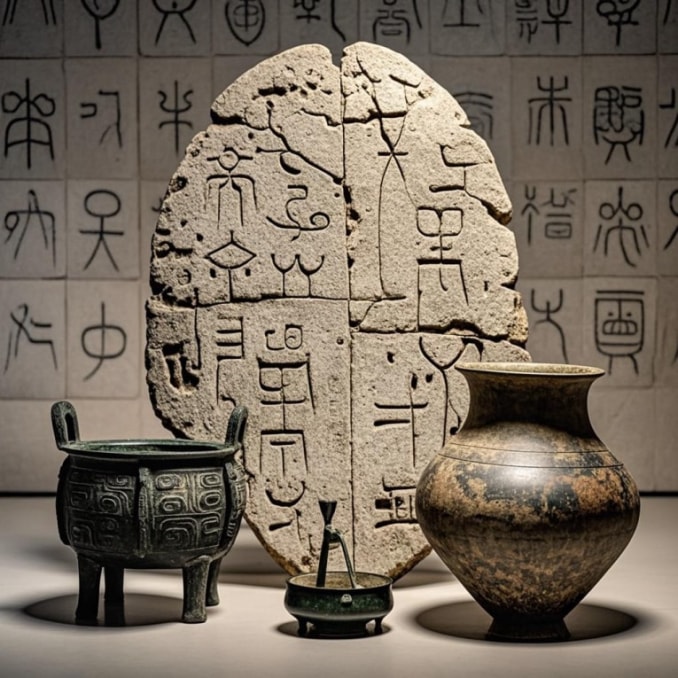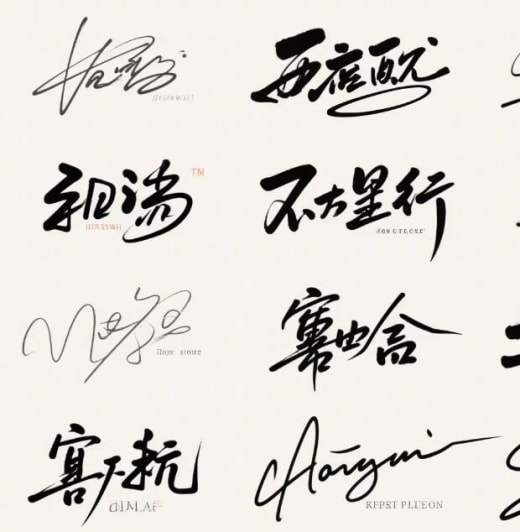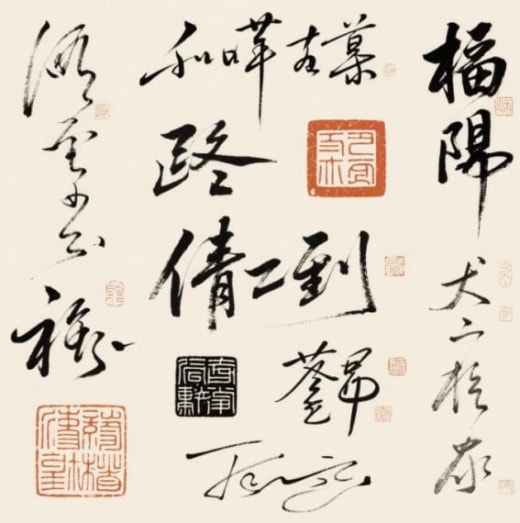The Origin and History of Chinese Names
中文名源于世界上最古老的象形文字系统之一,距今已有3500多年历史。甲骨文中的名字记载了商王的天干命名法,如"武丁"、"盘庚"等。这种文字系统直接影响了日语、韩语等东亚文字的发展。
Chinese names originate from one of the world's oldest pictographic writing systems, with a history spanning over 3,500 years. Oracle bone inscriptions record the naming methods of Shang kings, such as "Wu Ding" and "Pan Geng". This writing system directly influenced the development of East Asian scripts like Japanese and Korean.

商代甲骨文中的名字记载 / Name records in Shang Dynasty oracle bones
The Only Living Ancient Writing System
汉字是当今世界唯一仍在使用的古老文字系统,自甲骨文(约公元前1200年)延续至今,承载着连续不断的文明记忆。相比已消亡的古埃及象形文字、苏美尔楔形文字等,汉字展现了惊人的生命力。
Chinese characters are the only ancient writing system still in use today, continuing from oracle bone script (c.1200 BC) to the present, carrying uninterrupted cultural memory. Compared to extinct systems like Egyptian hieroglyphs and Sumerian cuneiform, Chinese demonstrates remarkable vitality.
埃及象形文/(消亡)
Egyptian Hieroglyphs苏美尔文/(消亡)
Sumerian Script现代汉字/(存活)
Modern Chinese Characters楔形文字/(消亡)
Cuneiform繁体汉字/(存活)
Traditional Chinese Characters世界主要古文字存活状态对比(向左滑动)
Comparison of ancient writing systems' survival status(Scroll Left)
Oracle Bone
商代占卜文,已识别约4,500字
Seal Script
秦始皇统一文字,确立标准
Clerical Script
汉字"隶变"关键期
Regular Script
沿用至今的标准字体
Simplified
现代标准化改革
Pictographic Writing Systems Comparison
| 对象 | 甲骨文 | 埃及文 | 玛雅文 |
|---|---|---|---|
| 人 | 𠤎 | 𓀂 | 𑄷 |
| 日 | ☀️ | 𓇳 | 𑄸 |
| 水 | 💧 | 𓈗 | 𑄹 |
不同古文明对相同概念的表征方式差异 / Different representations across ancient civilizations
从具象图画到抽象符号的渐进演变
保持装饰性,最终被拼音文字取代
复杂组合系统随文明消失
汉字结构训练空间认知和模式识别能力,研究表明使用汉字的人群在大脑处理上具有独特优势。
现代读者仍能部分理解两千年前的篆书,这种文化连贯性在世界文明中绝无仅有。
书法成为高雅艺术形式,每个名字都能转化为独特的视觉艺术品,这在拼音文字中难以实现。
"名"字本身由"夕"(夜晚)和"口"(说话)组成,表示在黑暗中通过呼唤名字来识别人,体现了名字最原始的社会功能。
The character "名"(name) combines "夕"(night) and "口"(mouth), representing identifying people by calling names in darkness, reflecting names' primal social function.
Writing System Comparison
| 文字类型 / Script | 起源时间 / Origin | 特点 / Features | 艺术表现 / Artistic Expression |
|---|---|---|---|
|
汉
汉字 / Chinese
|
约公元前1200年 / c.1200 BC | 象形表意,单音节,字形稳定 / Pictographic, monosyllabic, stable form | 书法艺术丰富,多种字体风格 / Rich calligraphy, multiple styles |
|
A
拉丁字母 / Latin
|
约公元前700年 / c.700 BC | 拼音文字,多音节组合 / Alphabetic, polysyllabic | 字体设计多样,但缺乏笔法变化 / Diverse fonts but limited stroke variation |
|
ア
日语假名 / Japanese Kana
|
约公元800年 / c.800 AD | 音节文字,源自汉字偏旁 / Syllabic, derived from Chinese radicals | 保留部分书法传统 / Retains some calligraphic tradition |
|
𓃭
埃及象形 / Hieroglyph
|
约公元前3000年 / c.3000 BC | 宗教用途为主,已消亡 / Mainly religious, extinct | 装饰性强,但缺乏发展 / Highly decorative but undeveloped |
中文名正成为跨文化交际中的首选标识,超越英文名的局限性
真正具有全球适应性的名字需要满足三大标准:发音易识别性、文化中立性和记忆友好性。中文名因其独特的音节结构和视觉符号系统,在这三方面展现出天然优势。
中文的四声系统比英语不规则发音更易掌握,如"马云"比"Jack Ma"在全球各语言中发音更稳定
汉字不依赖特定宗教背景,如"李娜"比"Maria"更中性,避免基督教文化联想
大脑处理汉字比拼音文字快0.2秒,视觉符号更易形成长期记忆(剑桥大学2022研究)

2023年《财富》500强亚裔高管中,60%优先使用中文名,仅30%使用英文名
中文名完整保留了三个阶段的文化基因,这是英文名无法比拟的
| 文化深度 | 汉字3000年 vs 英文1500年 |
| 信息密度 | 1汉字=2.7个字母(MIT研究) |
| 国际接受度 | 中文名增长47%(2020-2023) |
联合国文件中文版本比英文版平均节省28%篇幅
谷歌2024年报告:中文名简历打开率比英文名高35%
China's National Strength and Cultural Influence
世界第二大经济体,GDP超18万亿美元,拥有全球最多的世界500强企业。中文名在国际商务场合越来越常见。
The world's second largest economy with GDP over $18 trillion, hosting the most Fortune 500 companies. Chinese names are increasingly common in international business.
联合国教科文组织世界遗产总数世界第一,孔子学院遍布全球,春节成为多国法定节日。
Leads in UNESCO World Heritage sites, Confucius Institutes worldwide, and Spring Festival becoming a holiday in many countries.
中文是联合国官方语言,全球超1亿外国人学习中文,中文名在国际舞台彰显文化自信。
An official UN language, studied by over 100 million foreigners worldwide. A Chinese name demonstrates cultural confidence internationally.
The Artistic Expression of Chinese Names
中文签名艺术融合书法美学与个人风格,每个名字都能设计出独特的视觉标识。相比字母签名,中文签名更具辨识度和艺术价值。
Chinese signature art combines calligraphic aesthetics with personal style, creating unique visual identifiers for each name. Compared to alphabetic signatures, they offer greater distinctiveness and artistic value.



The Unique Advantages of Chinese Names
每个汉字都承载着数千年的文化积淀,名字组合可蕴含诗词典故、哲学思想或美好祝愿。
Each character carries millennia of cultural heritage, allowing names to embody poetry, philosophy or auspicious meanings.
相比常见的英文名,中文名在国际场合更易被记住,有助于建立独特的个人品牌。
Compared to common English names, Chinese names are more memorable internationally, aiding personal branding.
四声调系统创造丰富的韵律变化,名字读起来抑扬顿挫,富有音乐性。
The tonal system creates rich rhythmic variations, making names musically expressive.
方块字结构使名字在书写时自然形成对称美感,适合各种设计应用。
The square character structure creates natural symmetry, ideal for design applications.
中文名可音译为各种语言,同时保持原有意蕴,适合跨国交流。
Chinese names can be phonetically translated while retaining meaning, ideal for cross-cultural communication.
随着中国影响力提升,中文名将成为重要的文化资产和竞争优势。
As China's influence grows, Chinese names will become valuable cultural assets and competitive advantages.
Why You Need a Chinese Name?
一个中文名,即使是简单的几个字符,但可以轻松传播您与众不同,气质非凡。
一个恰当的中文名表明您尊重并理解他国文化,并且好的名字会带来好运。
在中文环境中,一个地道的中文名比音译名更容易被记住和正确发音。
在中国市场,拥有中文名的外国企业高管通常能获得更多信任和合作机会。

国际商务交流中使用中文名 / Using Chinese names in international business
中文名不仅是标识,更是文化传承的载体。我们的服务将帮助您获得一个既有深厚文化底蕴,又符合现代审美的好名字。
A Chinese name is not just an identifier, but a vessel of cultural heritage. Our service helps you acquire a name with profound cultural roots and modern appeal.

获得中文名的国际家庭 / International family with Chinese names
Our Professional Naming Advantages